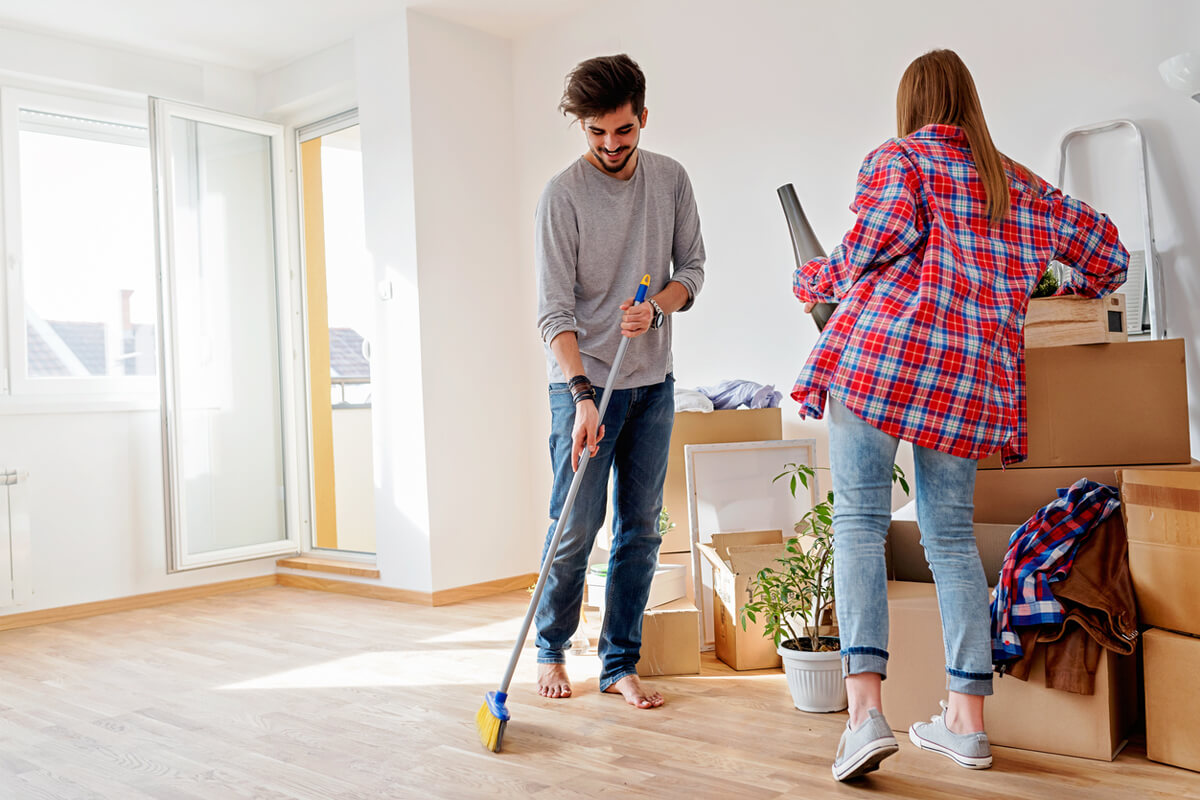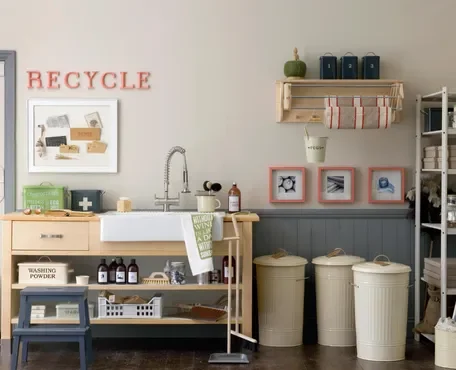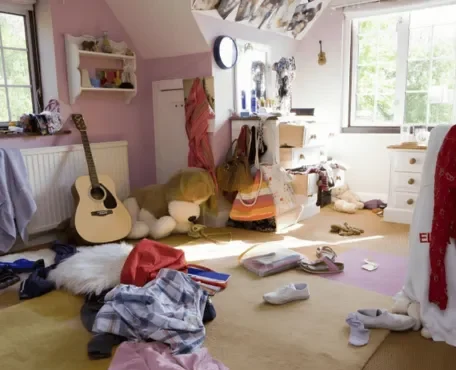
New Home Cleaning: Moving into a new home is an exciting experience, but it also comes with the task of cleaning and organizing your space to make it truly your own. A clean and well-maintained home not only enhances the overall living environment but also contributes to your well-being. In this article, we will explore various efficient ways to clean your new home, ensuring that it is a comfortable and healthy living space for you and your family.
Cleaning your new home can be a rewarding experience when approached systematically and efficiently. By developing a cleaning plan, gathering the right supplies, and following a routine, you can maintain a clean and healthy living environment. Taking the time to deep clean, declutter, and organize your new home will contribute to a more enjoyable and stress-free living experience for you and your family.
1.Develop a Cleaning Plan
Before you start cleaning your new home, it’s essential to create a cleaning plan. This plan will help you organize your tasks, set priorities, and allocate your time effectively. Begin by listing the areas and items that require cleaning, setting a timeline, and gathering the necessary cleaning supplies. Having a well-thought-out plan will make the process smoother and less overwhelming.
2.Gather the Right Cleaning Supplies
A successful cleaning project starts with the right tools and cleaning supplies. Ensure you have the following essentials:
a. Cleaning solutions: Invest in all-purpose cleaners, glass cleaners, disinfectants, and specific cleaners for various surfaces like wood, tile, and stainless steel.
b. Cleaning tools: Gather a variety of brushes, sponges, microfiber cloths, mop and bucket, vacuum cleaner, and a broom.
c. Safety gear: Don’t forget to include gloves and protective eyewear when dealing with harsh chemicals.
3.Start with a Deep Clean
A thorough deep cleaning is crucial when moving into a new home, as it ensures that you’re starting with a clean slate. Begin with the following:
a. Dusting: Dust all surfaces, including ceilings, walls, and baseboards.
b. Floors: Sweep, mop, or vacuum all floors. Consider steam cleaning carpets for a deep clean.
c. Kitchen: Clean all appliances inside and out, including the refrigerator, oven, and microwave.
d. Bathrooms: Scrub the tiles, clean the grout, and disinfect all surfaces.
e. Windows: Clean windows and mirrors to let in natural light.
f. Cabinets and closets: Wipe down shelves, and organize your belongings.
4.Tackle One Room at a Time
To make the cleaning process manageable, tackle one room at a time. Start with the rooms you use the most, such as the kitchen, living room, and bedroom. This approach allows you to see progress in each space and prevents you from feeling overwhelmed.
5.Declutter and Organize
As you clean each room, take the opportunity to declutter and organize. Sort through your belongings, and decide what to keep, donate, or discard. Organize your items to make the space more functional and aesthetically pleasing.
6.Prioritize High-Touch Surfaces
In the era of hygiene awareness, it’s essential to prioritize cleaning high-touch surfaces regularly. These include doorknobs, light switches, countertops, and remote controls. Use disinfectant wipes or solutions to thoroughly clean and sanitize these areas.
7.Develop a Cleaning Routine
After your initial deep cleaning, it’s crucial to establish a regular cleaning routine to maintain your new home’s cleanliness. A consistent schedule will help prevent dirt and grime buildup. Consider setting aside specific days for tasks like vacuuming, mopping, and bathroom cleaning.
8.DIY Cleaning Solutions
Consider using environmentally friendly and cost-effective DIY cleaning solutions. For example, a mixture of white vinegar and water can be used for cleaning glass and countertops, while baking soda is excellent for scrubbing stubborn stains.
9.Outdoor Cleaning
Don’t forget about the exterior of your new home. Clean the exterior walls, windows, and entryways. Ensure proper drainage to prevent mold and mildew growth. Additionally, maintain your outdoor space by regularly mowing the lawn, weeding, and cleaning outdoor furniture.
10.Seek Professional Help
In some cases, professional cleaning services may be necessary. If your new home has extensive cleaning needs, or if you lack the time and expertise, consider hiring a cleaning service to ensure your home is spotless and well-maintained.
Certainly, here are some additional tips and ideas for efficient new home cleaning:
11.Safety First
Safety should be a top priority during the cleaning process. Be cautious when using chemicals and cleaning products. Read product labels and follow instructions for proper use. Open windows for ventilation when using strong chemicals, and always wear appropriate safety gear, such as gloves and eye protection.
12.Don’t Forget Light Fixtures
Light fixtures tend to accumulate dust and dirt over time. Remove light covers and clean them thoroughly. Use a duster or a damp cloth to clean bulbs and fixtures. Well-cleaned light fixtures will not only brighten up your space but also improve indoor air quality.
13.Air Vents and Ducts
Cleaning air vents and ducts is often overlooked but can greatly improve air quality in your new home. Use a vacuum with a brush attachment to remove dust and debris from vents and ducts. Consider hiring a professional duct cleaning service if needed.
14.Pest Control
Inspect your new home for signs of pests and rodents. If you notice any issues, it’s essential to address them promptly. Consider setting up pest control measures or hiring a professional exterminator to prevent infestations.
15.Deep Clean Appliances
Apart from surface cleaning, deep cleaning appliances is important. For your refrigerator, clean the coils and remove and clean the shelves and drawers. Clean the lint trap in your dryer to prevent fire hazards. Regular maintenance can extend the lifespan of your appliances.
16.Grout and Tiles
Grout lines between tiles can accumulate grime and mold. Use a mixture of baking soda and water or a specialized grout cleaner to scrub and clean these areas. This will not only improve the appearance but also prevent mold growth.
17.Hard-to-Reach Areas
Don’t overlook hard-to-reach areas like behind large appliances, under furniture, and inside cabinets. Use an extendable duster or vacuum attachments to reach these hidden spaces. Cleaning these areas ensures a thorough clean and prevents pests and dust buildup.
18.Ceiling Fans and Light Fixtures
Ceiling fans and light fixtures are notorious for collecting dust. Use a long-handled duster or a microfiber cloth to clean the blades and fixtures. Regular cleaning prevents dust from falling onto your living spaces.
19.Regular Maintenance
To keep your new home consistently clean, establish a regular maintenance routine. This includes tasks such as changing air filters, checking for leaks, and performing small repairs as needed. Preventive maintenance reduces the risk of larger, more expensive issues in the long run.
20.Green Cleaning
Consider using eco-friendly and non-toxic cleaning products. They are better for your health and the environment. Many commercial cleaning products now offer green alternatives that are just as effective as traditional cleaners.
21.Family Involvement
Cleaning your new home can be a family project. Get everyone involved in age-appropriate cleaning tasks. Not only will it make the cleaning process faster, but it’s also a great way to teach responsibility and teamwork to your children.
In conclusion, efficient new home cleaning involves a combination of planning, organization, and routine maintenance. By addressing both visible and hidden areas, you’ll create a clean and healthy living environment that you and your family can enjoy for years to come. Remember to maintain your cleaning routine to ensure your new home remains a welcoming and comfortable space.
Certainly, here are some frequently asked questions related to new home cleaning and their answers:
Q1: How often should I deep clean my new home?
A1: Deep cleaning should be done when moving into a new home to ensure that it’s a clean slate. After that, it’s recommended to deep clean your home at least once or twice a year. Regular cleaning routines, like dusting, vacuuming, and surface cleaning, should be done more frequently, ideally on a weekly or bi-weekly basis.
Q2: What’s the best way to clean high-touch surfaces in my home?
A2: High-touch surfaces like doorknobs, light switches, and countertops should be cleaned and sanitized regularly. Use disinfectant wipes or a mixture of water and isopropyl alcohol (70% or higher) to clean these surfaces. Follow the instructions on the product label for contact time, as some disinfectants require a specific duration to be effective.
Q3: Are homemade cleaning solutions as effective as commercial cleaners?
A3: Homemade cleaning solutions can be just as effective as commercial cleaners, depending on the task. For general cleaning, solutions made with ingredients like white vinegar, baking soda, and lemon juice are excellent choices. However, for specialized cleaning tasks or disinfection, commercial products designed for specific surfaces and purposes might be more effective.
Q4: How can I remove stubborn stains from carpets and upholstery?
A4: Stubborn stains can be challenging to remove. Start by blotting the stain with a clean cloth to absorb as much of the spill as possible. Then, use a stain-specific cleaner or a mixture of mild dish soap and water to treat the stain. Gently blot and avoid rubbing, as rubbing can push the stain deeper into the fabric. For tough stains, consider hiring a professional carpet cleaner.
Q5: What’s the best way to clean and maintain hardwood floors?
A5: Hardwood floors should be swept or vacuumed regularly to remove dirt and debris. To clean, use a hardwood floor cleaner that is safe for your specific floor finish. Avoid excessive water, as it can damage the wood. Instead, use a damp mop or microfiber cloth. Wipe up spills promptly to prevent staining and warping.
Q6: How can I prevent mold and mildew growth in my new home?
A6: Preventing mold and mildew involves controlling moisture. Ensure proper ventilation in bathrooms and the kitchen, and fix any leaks promptly. Use a dehumidifier in areas prone to humidity. Regularly clean and disinfect areas prone to mold growth, like bathrooms, and consider using mold-resistant paint in moisture-prone areas.
Q7: What should I do if I don’t have time to clean my new home thoroughly?
A7: If you’re short on time or the cleaning needs are extensive, consider hiring a professional cleaning service. They have the expertise and tools to deep clean your home efficiently. Alternatively, you can break the cleaning tasks into manageable chunks and tackle them over several days or weeks.
Q8: Can I clean the exterior of my home on my own, or do I need a professional?
A8: Cleaning the exterior of your home is something you can do on your own, but it can be labor-intensive and may require specific equipment for hard-to-reach areas. Pressure washing is an effective method for cleaning siding and decks. If you’re not comfortable doing it yourself or have a particularly large area to clean, consider hiring a professional for safety and efficiency.
These are some common questions and answers related to cleaning your new home. Cleaning and maintaining your new space is essential for creating a comfortable and healthy living environment. If you have specific questions or concerns, don’t hesitate to seek expert advice or consult cleaning professionals.








